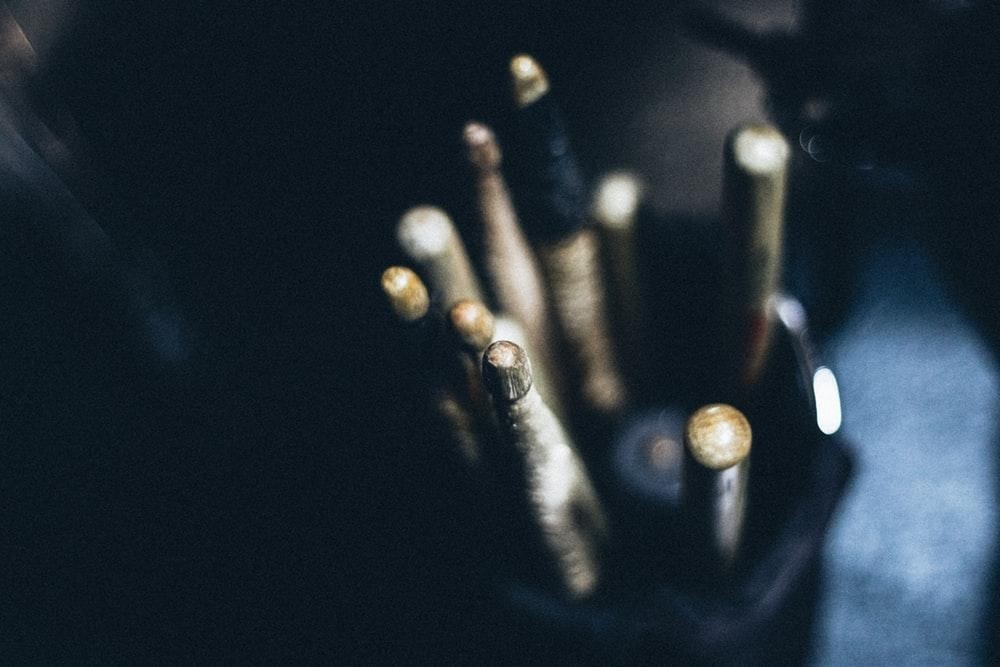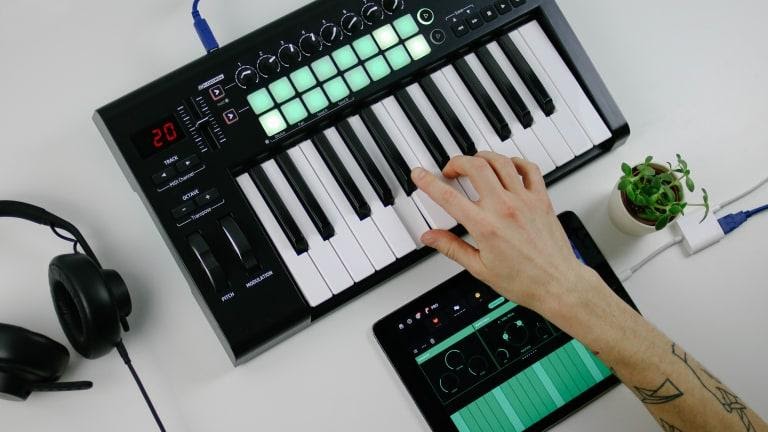Picking drumsticks or any drum playing tool is an incredibly personal and varied choice. However, knowledge is half of the battle.
Different styles of music require different sounds from the drum kit, from soft and mellow to hard and punchy. While most people are aware that you’d use a different stick for Jazz and Metal, there’s a lot more to it than you might think!
Knowing which products are available means you can pick the best tool for the job.
The Drum Stick
Almost all drum sticks are made from different types of wood. Depending on the style of wood used, softer or harder, it changes the durability of the stick significantly.

Because wood is easily crafted, you can get tips made in different shapes. We use oval tips for a general-purpose rounded sound suitable for pop and folk, and barrel tips for loudness suited for playing in a marching or metal band. You can also get nylon tipped drum sticks, which give a different attack to the sound. The debate over whether or not nylon tips are any good is heated and best left alone. See what works for you and choose accordingly.
A drum stick changes width along the length of the stick. This is called ‘taper’. The taper of a stick gives a character to the sound it creates, so it is crucial from a tonal perspective. A thicker taper is best for loud, intense beats while a narrower taper is better for a lighter sound.
Drumstick Classification
Drum sticks come in different sizes, which determines the circumference of the stick. They are commonly found in “2”, “5” and “7” circumferences. The former is on the thicker end of the spectrum while the 7” class is thin.
In addition to the size label, each stick is represented by a letter. ‘A’ is for orchestral percussion, ‘B’ is for a typical band setting and ‘S’ for street drumming or marching.
Each stick has a personality that is only unlocked when the drummer opts to widen their knowledge about the tool. Genre-wise, you’ll usually be using wooden sticks for Pop, Rock, Metal and Funk music.
Now let’s take a look at some alternates to drum sticks.
Orchestral Drumsticks

Orchestral sticks vary quite a bit from standards sticks, both by construction and by material. In an orchestra, snare drums are often the most used. For this, materials such as rosewood, birch and ash can be used to make resonant, open sounding snare hits. These woods tend to be a little softer than the maple of the usual sticks, which means they are unsuitable for hitting cymbals and hi-hats with, so do be careful with them.
Drum Brushes
Brushes are small, plastic casings which have fine fibers inside, creating a brush shaped head to the stick. You can tighten and loosen the fibers using the handle at the foot of the stick, changing the sound produced.
With a drum brush, you can get both nylon and metal bristles, which give different sounds in application. While brushes aren’t used in many genres, they give a unique, soft tone to drums, which is incredibly useful for those splashy cymbals commonly found on countless jazz records and orchestral percussion. You can also use these on a cajon for a great vintage sound.

For those genre-bending virtuosos out there, you can get sticks that have both brushes and tips, on opposite ends. This works really nicely in situations where you have a rock or metal part in a song, straight in to a jazzy interlude or bossa nova part.
Percussion Mallets
While Percussion Mallets are mostly designed for playing orchestral percussion with, playing the drum kit with them can be an exciting experiment. The mallets produce a different sound from the hi-hat and cymbals, as well as a softer snare sound.

Mallets can be unwrapped or wrapped in a number of different materials ranging from brass, rubber and nylon to metal, felt and acrylics. Each one of these give a different sound, which once again is left for you to test and decide. Mallets could be used for jazz and softer musical styles, but wouldn’t be great for metal or rock. Classical percussionists often hold two mallets in a matched grip in each hand. This allows them to have multiple materials available, enabling sounds that most composers envisage.
Rutes
Rutes are, simply put, multiple drum sticks taped together that are used as a midway point between a stick and a brush. These are really good for traditional instruments such as a bodhrán. They are also comparatively quite even when the drums are hit hard.

Summary
To summarize, you’ll be using drumsticks for most mainstream music like folk, pop, rock, and funk. Brushes are fantastic for some orchestral settings, jazz and acoustic music. Rutes, mallets and other special case sticks are used usually sparingly with instruments like gongs and timpani.

We stock a wide variety of drumsticks and mallets. We hope this information helps you pick out the perfect set for your needs.
We are building a community of musicians and creators in the Middle East – those not afraid to follow their dreams and expand creative horizons. One way we support aspiring, active creators on their journey is by sharing a variety of content and information across essential topics in this complex and exciting industry of musical instruments and content creation gear.
When you're looking to pick up instruments or music and sound gear, get in touch with us for recommendations, the latest information on new and discontinued models, as well as sales and promotions. Whether you’re looking for a guitar, a keyboard, a piano, a drum kit, studio recording equipment, music production tools, or DJ gear – we can promise the widest variety, knowledgeable advice and the lowest prices across Dubai, Abu Dhabi, Sharjah, UAE, the Sultanate of Oman, the Kingdom of Bahrain, the State of Kuwait, and the Kingdom of Saudi Arabia.





